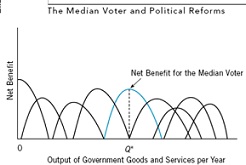Response to the following problems
1. Suppose the positions of political candidates on all issues can be ranked on a scale of conservative to liberal. The more conservative a candidate, the less the quantity of public goods he will supply. Suppose as well that all voters favoring liberal candidates will vote while only 50 percent of those favoring conservative candidates will vote. Use a graph like the one drawn in Figure to show how the political equilibrium will differ from an election in which all citizens vote.

Given tax shares, the political party proposingQ* units of government goods and services per year will win an election over any other party proposing an alternative quantity. This is becauseQ* is closer to the most-preferred outcome of a simple majority of the voters.
2. Suppose the military bureaucracy consistently misinforms Congress on the total costs of producing military hardware. Assume that it underestimates the actual costs and that the political representatives believe these estimates. Show how this is likely to cause a loss in efficiency. Show the efficient output of military hardware, the output desired by the military bureaucracy, and how the output chosen will differ from he efficient output even if Congress attempts to achieve efficiency. In your answer, assume that the military seeks to maximize the size of its budget.